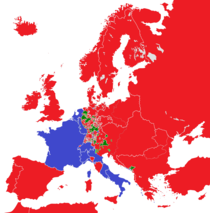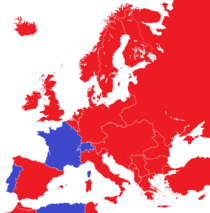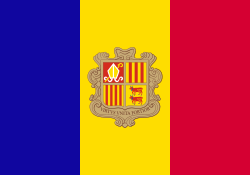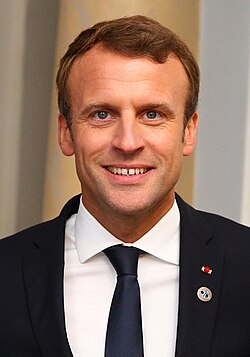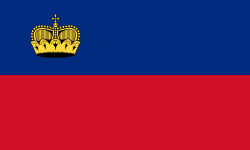Seznam monarchií v Evropě

Monarchie byla převládající formou vlády v dějinách Evropy po celý středověk, jen příležitostně konkurovala komunalismu, zejména v případě námořních republik a Švýcarské konfederace.
Republikanismus se v raném novověku čím dál tím více objevoval, ale monarchie v Evropě, i během 19. století, převládala. Od konce první světové války však byla většina evropských monarchií zrušena. V roce 2024 v Evropě zbývá dvanáct svrchovaných monarchií. Sedm je království: Dánsko, Norsko, Švédsko, Spojené království, Španělsko, Nizozemsko a Belgie. Andorra, Lichtenštejnsko a Monako jsou knížectví a Lucembursko je velkovévodství. Vatikán je teokratická volená monarchie ovládaná papežem.
Monarchie lze rozdělit do dvou širokých tříd: předmoderní státy a státy, které získaly svou nezávislost během napoleonských válek nebo bezprostředně po nich. Dánsko, Norsko, Švédsko, Spojené království, Španělsko a Andorra jsou zástupci předmoderních monarchií. Lichtenštejnsko, Nizozemsko, Belgie a Lucembursko byly během napoleonských válek založeny nebo si různými metodami získaly nezávislost. Vatikán byl uznán jako svrchovaný stát spravovaný Svatým stolcem v roce 1929.
Deset z těchto monarchií je dědičných a dvě jsou volené: Vatikán (papež zvolený na konkláve), a Andorra (technicky polovolená diarchie, přičemž hlavami státu jsou zvolený prezident Francie a biskup z Urgellu jmenovaný papežem).
Většina monarchií v Evropě jsou konstituční monarchie, což znamená, že monarcha neovlivňuje politiku státu: buď je to monarchovi ze zákona zakázáno, nebo monarcha nevyužívá svěřené politické pravomoci úřadu. Výjimkou jsou Lichtenštejnsko a Monako, které jsou obvykle považovány za polokonstituční monarchie kvůli velkému vlivu, který knížata stále mají na politiku, a Vatikán, který je absolutní monarchií. V současné době neexistuje žádná velká kampaň za zrušení monarchie (viz monarchismus a republikanismus) v kterémkoli z těchto dvanácti států, ačkoli v mnoha z nich je malá menšina republikánů (např. politická organizace Republika ve Velké Británii). V současné době je šest z dvanácti monarchií členy Evropské unie: Belgie, Dánsko, Lucembursko, Nizozemsko, Španělsko a Švédsko.
Na začátku 20. století byly Francie, Švýcarsko a San Marino jedinými evropskými státy, které měly republiku, jako formu vlády. Vzestup republikanismu k politickému mainstreamu začal až na počátku 20. století, což usnadnilo svržení různých evropských monarchií válkou nebo státním převratem. Na počátku 21. století je většina evropských států republikami s přímo nebo nepřímo volenou hlavou státu.
Historie
Vývoj území
Seznam současných evropských monarchií
Tabulka monarchií v Evropě
Související články
Média použitá na této stránce
Evropské monarchie
Autor: Nederlandse Leeuw, Licence: CC BY-SA 4.0
Monarchies, republics and ecclesiastical lands in Europe in 1714.
Autor: Nederlandse Leeuw, Licence: CC BY-SA 4.0
Monarchies, republics and ecclesiastical lands in Europe on the eve of the French Revolution in 1789.
Autor: Nederlandse Leeuw, Licence: CC BY-SA 4.0
Monarchies, republics and ecclesiastical lands in Europe near the end of the French Revolution. On 21 January 1799, the proclamation of the Parthenopean Republic marked the peak of the period of sister republics – states founded on territories conquered by French and local revolutionary armies between 1795 and 1799 that were modeled after and loyal to the French First Republic. These were located in the Low Countries, the German Rhineland, Switzerland and Italy.
Autor: Nederlandse Leeuw, Licence: CC BY-SA 4.0
Monarchies and republics in Europe on 8 July 1815 (Second restauration of Louis XVIII of France after Napoleon's Hundred Days).
The Ottoman Empire and Russian Empire are counted amongst Europe.
Counted as republics are the Swiss Confederation, the Free Cities of Hamburg, Bremen, Lübeck and Frankfurt, the Most Serene Republic of San Marino, the Republic of Cospaia, the Septinsular Republic and the German Confederation; however, member states of the German Confederation are also separately counted (35 monarchies).Autor: Nederlandse Leeuw, Licence: CC BY-SA 4.0
Monarchies and republics in Europe on 28 June 1914 (Assassination of Archduke Franz Ferdinand of Austria), on the eve of the First World War.
Autor: Nederlandse Leeuw, Licence: CC BY-SA 4.0
Monarchies and republics in Europe in 1930.
Autor: Nederlandse Leeuw, Licence: CC BY-SA 4.0
Monarchies and republics in Europe in 1950.
Autor: Nederlandse Leeuw, Licence: CC BY-SA 4.0
Monarchies and republics in Europe in 2015.
Autor: Conferencia Episcopal Española, Licence: CC BY-SA 2.0
Mons. Vives
Autor: Arno Mikkor, EU2017EE Estonian Presidency, Licence: CC BY 2.0
Emmanuel Macron, Tallinn Digital Summit, 2017
This is the national flag of Belgium, according to the Official Guide to Belgian Protocol. It has a 13:15 aspect ratio, though it is rarely seen in this ratio.
Its colours are defined as Pantone black, Pantone yellow 115, and Pantone red 032; also given as CMYK 0,0,0,100; 0,8.5,79,0; and 0,94,87,0.Autor: Paul Hermans, Licence: CC BY 4.0
King Philippe of Belgium at the national parade on 21 July 2018.
Autor: Søren Rasmussen, Licence: PDM-owner
Ved fejringen af genforeningsjubilæet den 13. juni 2021. Koldings viceborgmester Søren Rasmussen med Prins Christian og Kronprins Frederik.
Flag of Liechtenstein
Autor: GuentherZ, Licence: CC BY-SA 3.0
Ο πρίγκιπας Ιωάννης Αδάμ Β΄ του Λίχτενσταϊν το 2013
Autor: claude piscitelli - www.pitsch.lu, Licence: CC BY 2.5
Grand Duke Henri of Luxembourg
(text from original picture: "CGDL Audience M. George Tsereteli, président de l'Assemblée Parlementaire de l'OSCE - Luxembourg - Ville - Palais Grand-Ducal - 25/03/2019 - photo: claude piscitelli"
Autor: www.GlynLowe.com, Licence: CC BY 2.0
The Dutch royal couple and its delegation will be welcomed by Hamburg’s First Mayor Olaf Scholz at city hall on March 19, 2015. Then, the royals will attend the closing ceremony of the trilateral conference: “Offshore Wind in the Netherlands, Germany and Denmark, a contribution to the European Energy Transition” in the Hamburg Chamber of Commerce. On its panel, German, Dutch and Danish experts will talk about the contribution of the three countries towards the energy revolution in Europe. The three speeches on the agenda will be held by His Majesty King Willem-Alexander, Hamburg’s First Mayor Olaf Scholz, and the former President of the Hamburg Chamber of Commerce, Dr. Karl-Joachim Dreyer. Aftwerwards, the royal couple will be asked to sign the guestbook of the Hamburg Chamber of Commerce.
More Photos At:
www.glynlowe.com/king-willem-alexander-and-queen-maxima-in-hamburgAutor: Tor Atle Kleven, Licence: CC BY-SA 2.0
Kong Harald V på åpningen av nye St Olavs hospital i Trondheim 12. juni 2010.
King Harald on the opening on the new St Olavs hospital in Trondheim on 12 June 2010.
The license on this photo is Creative Commons (CC-BY-SA).
If you use this picture, remember to give credit according to the license (https://creativecommons.org/licenses/by-sa/3.0/).Autor: Cancillería Ecuador, Licence: CC BY-SA 2.0
Felipe de Borbón en el momento en que da la mano al presidente de Ecuador, en Quito
Autor: Bengt Nyman from Vaxholm, Sweden, Licence: CC BY 2.0
Crafoord Prize 2018, Geosciences, Kungliga Vetenskapsakademien, Syukuro Manabe and Susan Solomon
President Joe Biden greets Britain's Prince Charles, Tuesday, November 2, 2021, during the COP26 U.N. Climate Change Conference at the Scottish Event Campus in Glasgow, Scotland. (Official White House Photo by Adam Schultz)
The Flag of Vatican City State, as per the 2023 w:en:Fundamental Law of Vatican City State, reproducing Annex A which contains the official depiction of this version. See 2023 Fundamental Law of Vatican City State, art. 23, n. 1.
This 2023 flag is very similar to the flag used in the 1929 Fundamental Law of Vatican City State, see here, p. 35. Thus, it is in the public domain.
The Flag of Vatican City State, as per the 2023 w:en:Fundamental Law of Vatican City State, reproducing Annex A which contains the official depiction of this version. See 2023 Fundamental Law of Vatican City State, art. 23, n. 1.
This 2023 flag is very similar to the flag used in the 1929 Fundamental Law of Vatican City State, see here, p. 35. Thus, it is in the public domain.
Autor: Jeffrey Bruno from New York City, United States, Licence: CC BY-SA 2.0
ROME,VATICAN 27 APRIL: "Images taken from what will go down in history as one of the largest and most important days in current history. The Canonization of Blessed Pope John XXIII and Blessed Pope John Paul II. Two beloved Popes from the 20th Century."


